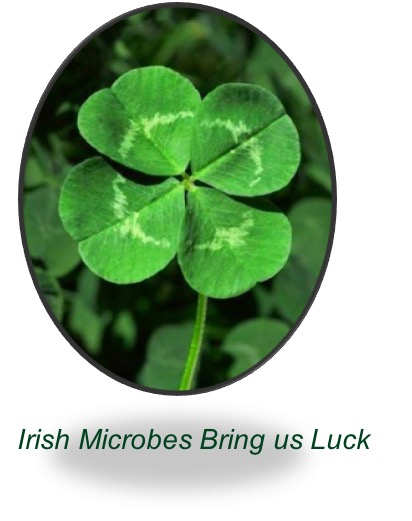Summary
Kryptonite Against Superbugs
The discovery of novel antibiotics gives microbiologists a powerful "kryptonite", against "Superbugs". Antibiotic-resistant microbes, called "Superbugs", can be killed off by new antibiotics. This is because "Superbugs" have not yet developed resistance to new antibiotics.

Microbes in Ireland
The land of Eire harbors microbes that make unusual antibiotics. These novel antibiotics can kill "superbugs". "Superbugs" are the microbes that have developed a resistance to the regular antibiotics we've been using in medicine for years. This is why they have built up a tolerance to the antibiotics and can no longer be stopped by them. There is an acronym, ESKAPE, that uses the first letter of the names of the microbes we presently know are "superbugs". But the good news from Irish soil and sea sponges is this: There are new, never-before-seen antibiotics that can kill these super-resistant ESKAPE microbes, and they are made by the microbes that live in Ireland!
West Fermanagh, Boho, Northern Ireland
These special microbes live in an alkaline soil. Limestone was deposited 335 million years ago in this soil. This area was used for ritual by the Druids. It was a symbolic place for Neolithic peoples. Microbiologists discovered these bacteria with its anti-superbug powers, researching an ethnopharmacological treatment. This is a folk cure that involves using this soil to cure toothaches and sore throats. The microbiologists identified a Streptomyces species, which is a well-known producer of antibiotics. This particular Streptomyces sp. grows at a high alkaline pH (10.5) and is tolerant of gamma radiation. Genomic sequencing identified many alkaline tolerance genes compared to S. coelicolor (described in the Guidebook). This new strain was called Streptomyces sp. myrophorea, from the Greek, myro (fragrance) and phorea (porter/carrier). Tests were run with this newly isolated bacterium. And these tests showed the new microbes could inhibit the growth of many strains of ESKAPE pathogens. For example they inhibit carbapenem-resistant Acinetobacter baumannii (a critical pathogen on the WHO priority list of antibiotic-resistant bacteria). It also inhibited vancomycin-resistant Enterococcus faecium, and methicillin-resistant Staphylococcus aureus (also known as MRSA). So, the science of modern-day microbiologists and beliefs of the ancients who recognized the curative properties of this Boho soil, find a common ground. And Streptomyces sp. myrophorea, from these Irish soil. shows it can inhibit ESKAPE pathogens. This supplies scientific proof for the cures that the ancients of Ireland had been using successfully for generations.
Microbe from Irish Sea Sponge
Pseudovibrio axinellae is a Gram-negative, rod-shaped, motile bacterial strain. It was cultured from an Irish marine sponge, called Axinella. And it lives in a mutualistic relationship that begins way before the sponge is fully grown. This microorganism is transferred from sponge to sponge while the sponge is still in its larval stage. These unusual microbes are a source of never-before-seen antibiotics. P. axinellae, lives on the corrugated surface of the sea sponge. And it produces two potent antibiotics, Heptylprogiogiosin and Tropoditheitic acid. These antibiotics are produced by P. axinellae to keep competitors out of its home: The comfortable microhabitat inside the sponge. The sea sponge enjoys a mutually beneficial relationship with the microbe as it tolerates the residency of P. axinellae. Because, by producing these antimicrobials, P. axinellae keeps the sea sponge exterior surface clean of all other invading and possibly more harmful bacteria. In turn, the microbe gets to live a predator-free life upon the sea sponge, because sea sponges also contain protective compounds to keep most pathogenic bacteria away.
By JeM YinJoy









